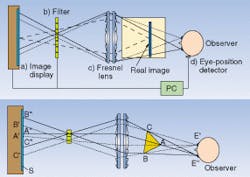Virtual objects are within hand's reach
THREE-DIMENSIONAL DISPLAYS
Incorporating news from O plus E magazine, Tokyo
TOKYOThe Communications Research Laboratory of the Ministry of Posts and Telecommunications has developed a stereoscopic display combining real image generation and binocular parallax exhibition. The display does not require glasses. Accurate binocular parallax display is achieved by detecting the position of both eyes and controlling an optical filter device.
Stereoscopic display system contains an image display panel that can present two types of images separable by using polarization effects, an optical filter device that selectively transmits the two types of images, a large Fresnel lens, and a binocular 3-D position-detection device (top). The image panel displays points corresponding to points a, b, and c as points A1, B1, C1, A", B", and C" on the surface of the 3-D virtual image (bottom). The filter is controlled at the points that intersect the optical path connecting the eyes (E1 and E"), the points on the 3-D image, and the corresponding points on the panel surface S. When the viewer moves, the point on the filter and the displayed image also change. The position of the viewer is measured at around 30-50 Hz; new images reflecting the change in 3-D position data can be generated in less than 20 ms.
This achievement is the result of an initiative by the organization's Multimedia Virtual Laboratory. The project aims to make manual simulations possiblefor example, of medical surgery. The group is conducting research on glasses-free three-dimensional (3-D) displays that the viewer can control as if directly manually manipulating the image. Previously, stereoscopic displays that used binocular parallax were particularly weak at displaying 3-D images in the hand region: that is, they could not reconcile depth perception due to focal-point adjustments and depth perception due to binocular parallax. For this reason, it was impossible to achieve critical control as if manipulating the image itself.
The two types of images presented in the system's display panel have different polarizations (see figure). Different images are sent selectively to the right and left eyes by the filter. A Fresnel lens is responsible for image formation in the hand region. Two methods have been used to detect the 3-D position of the eyes: either estimation via a magnetic sensor attached to the head, or direct detection via a stereo camera and image processing. The sizes of the image screens used were 42 and 70 in. The Fresnel lens was either a 35-in.-diameter round lens or a 65 x 55-cm rectangular lens.
This method results in a stereoscopic image within hand's reach of the viewer that has little discrepancy between binocular parallax and the focal-point adjustment of the eyes. High-accuracy depth perception and realism can be achieved, along with a stereoscopic image that can be virtually manipulated by hand. Because of the reduction of visual discrepancies, the kind of discomfort often associated with stereoscopic displays is reduced. The device requires no fine manufacturing, so production costs can be controlled. Future research will concentrate on miniaturization of the stereoscopic display system.
Courtesy O plus E magazine, Tokyo

